Training employees is costly and time-consuming, so understanding how effective training is can be essential to make sure resources aren’t wasted. This guide to training evaluation models breaks down the various approaches you can take, and how the 360-degree feedback model can deliver the best results.
Gain greater insights into the effectiveness of training through the 360-degree feedback model
The only thing worse than training your employees and having them leave is not training them and having them stay.
Henry Ford, founder of the Ford Motor Company
360-degree feedback is often associated with employee performance. But it can also be a powerful tool to gain insights into training and development.
With training programs costing companies time and money, it’s important to know they are getting a return on their investment. Not all training delivers clear cut results. While courses and training modules have graded results that can be measured, the development of soft skills is more ambiguous.
It isn’t always clear where an employee’s blind spots lie. The 360-degree feedback model can be an effective tool for revealing shortcomings that need attention. Data gathered through the 360-degree feedback process not only highlights these blind spots so appropriate training can be offered. It also indicates how effectively this training develops skills.
Streamlining training and development is a crucial part of strong performance management. The article from Gallup, Why It’s Time to Disrupt the Traditional Approach to L&D, outlines why getting training right is so important.
“The future of work will be more nimble, complex, digital and collaborative than ever before. For employees, the demands of this future environment will be considerable and constantly changing. Consequently, if leaders don’t change the way they approach development, they cannot expect sustained performance excellence.”
Examples of new learning methods include:
- Virtual learning
- Micro-learning
- e-learning
- Gamification
Training evaluation models are essential to keep your company’s approach to development on the right track. Choosing the best learning methods will help employees develop their talents while increasing productivity and retention.
As the Gallup article highlights, new methods of training and development are constantly emerging. A great training evaluations model will help make sure you’re always using the best ones available.
Why use training evaluation models?
TraIning evaluation models allow you to analyse how effective your training programs are in a number of ways. While there is a range of models available, each of these seeks to:
- Determine if the training was successful
- Understand what the participants learned
- Analyse the impact on the company
- Understand how relevant the skills are for the role
- Find out if the training was a good investment
- Understand how the training could be improved
- Tie the training module to productivity and engagement
- Understand how training links to company goals
- Redirect efforts towards other, more effective, approaches to training
Training evaluation models give business leaders a chance to see exactly how effective training is for achieving goals. These evaluations reveal what works and what doesn’t, so future training programs can be improved.
What are training evaluation models? A brief summary of approaches
Training evaluation models come in a range of approaches. Several key factors in various methods can be applied to the 360-degree feedback model used to assess training.
Let’s take a look at some of the more commonly used methods in more detail.
The Kirkpatrick Model
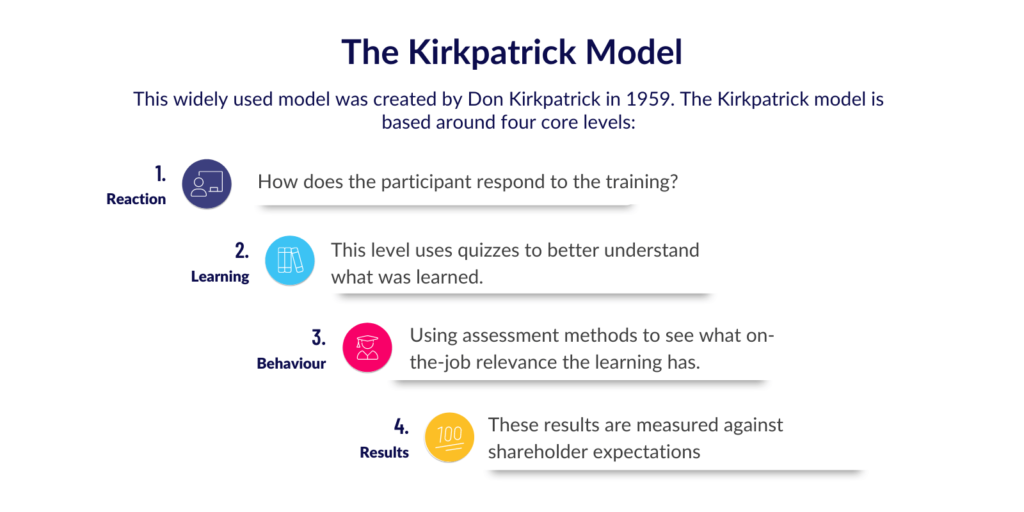
This widely used model was created by Don Kirkpatrick in 1959. The Kirkpatrick model is based on four core levels:
- Reaction. How does the participant respond to the training?
- Learning. This level uses quizzes to better understand what was learned.
- Behaviour. Using assessment methods to see what on-the-job relevance the learning has.
- Results. These results are measured against shareholder expectations.
This is one of the most common training evaluation models in use. It has also served as the basis for other training evaluation models.
The CIRO Model
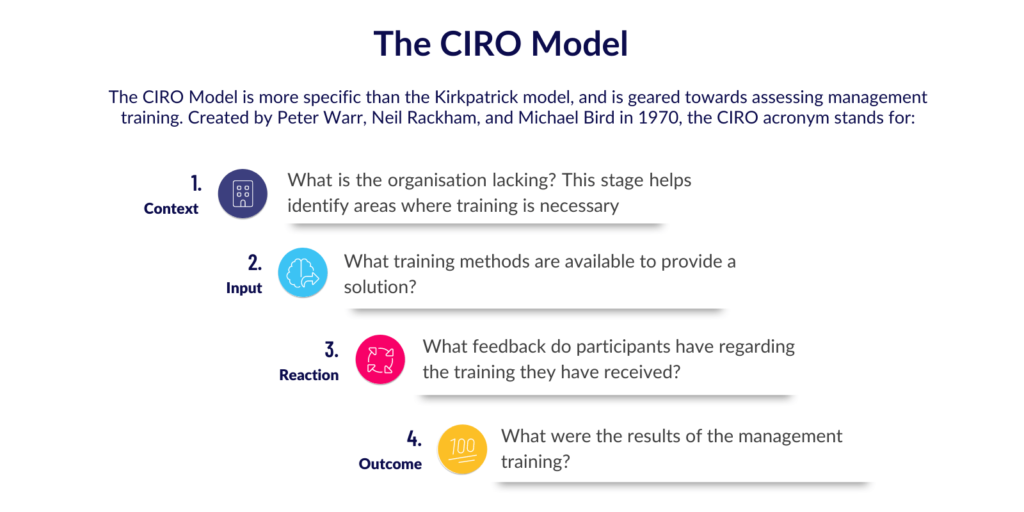
The CIRO Model is more specific than the Kirkpatrick model and is geared towards assessing management training.
Created by Peter Warr, Neil Rackham, and Michael Bird in 1970, the CIRO acronym stands for:
- Context. What is the organisation lacking? This stage helps identify areas where training is necessary.
- Input. What training methods are available to provide a solution?
- Reaction. What feedback do participants have regarding the training they have received?
- Outcome. What were the results of the management training?

The Phillips ROI Model
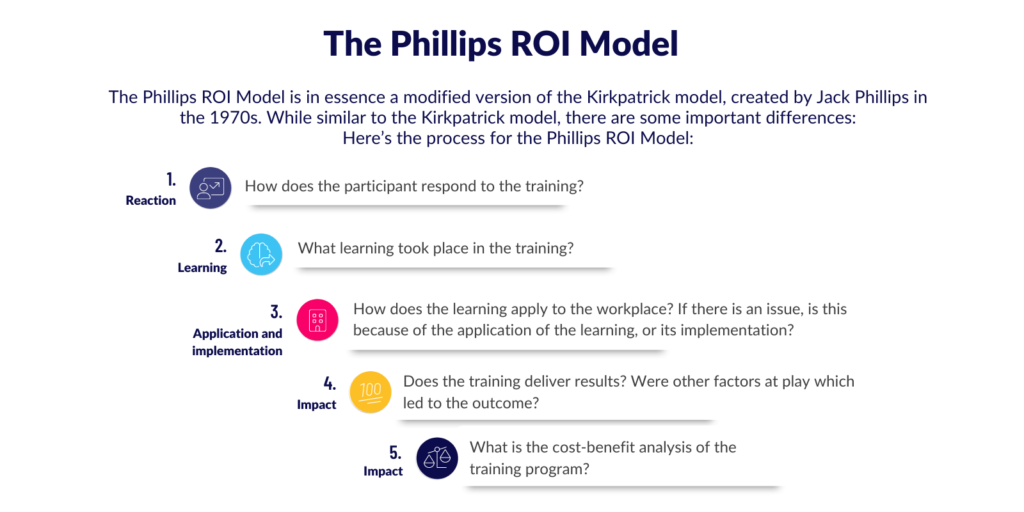
The Phillips ROI Model is in essence a modified version of the Kirkpatrick model, created by Jack Phillips in the 1970s. While similar to the Kirkpatrick model, there are some important differences:
Here’s the process for the Phillips ROI Model:
- Reaction. How does the participant respond to the training?
- Learning. What learning took place in the training?
- Application and implementation. How does the learning apply to the workplace? If there is an issue, is this because of the application of the learning, or its implementation?
- Impact. Does the training deliver results? Were other factors at play which led to the outcome?
- Return on investment. What is the cost-benefit analysis of the training program?
The ROI aspect of the Phillips model gives valuable additional insight. However, the costs associated with this process prohibit its use for most training evaluations.
The Brinkerhoff Model
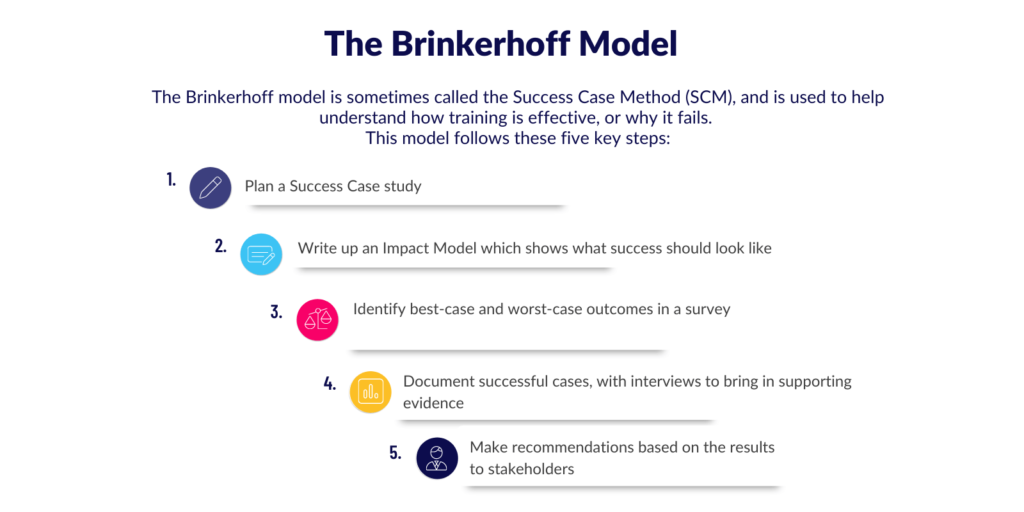
The Brinkerhoff model is sometimes called the Success Case Method (SCM), and is used to help understand how training is effective, or why it fails.
This model follows these five key steps:
- Plan a Success Case study
- Write up an Impact Model which shows what success should look like
- Identify best-case and worst-case outcomes in a survey
- Document successful cases, with interviews to bring in supporting evidence
- Make recommendations based on the results to stakeholders
These various approaches to training evaluation models all seek to understand the effectiveness of learning programs in different ways. Now, let’s see how the 360-degree feedback model can be used for training evaluation, drawing upon many of the key elements outlined above.
Using the 360 degree feedback model for training evaluation
Evaluation is not an afterthought to training, but rather is meant to be integrated into the entire learning and development process.
James D. Kirkpatrick, Kirkpatrick’s Four Levels of Training Evaluation
The goals outlined in the above methods can all be achieved by using the 360-degree feedback model. This gives valuable insights into an employee’s level of performance before and after any training.
The broad nature of 360-degree feedback means that this analysis allows for a thorough evaluation of the impact on performance any training delivers. It’s also an effective method to help decide what training an employee needs the most. Managers are better positioned to suggest appropriate training when they are clear on their employees’ blind spots.
A study from the Journal of Managerial Psychology explains:
“When 360 feedback is presented in a modified Johari window, managers can see the skills they need to improve. The use of 360 feedback can be the first step, unfreezing current behaviour … In addition, by conducting 360 feedback before and after the training, the first step in evaluating the effectiveness of the training can occur. In addition, the second round of feedback can be used both as reinforcement of past learning and also an opening for future learning.”
Using the 360 degree feedback model to design training modules
Training modules are time-consuming and costly. With 360-degree feedback, business leaders and HR professionals can analyse weaknesses at the individual and group level. This allows them to focus resources in the best places.
For example, a company might be interested in improving the competencies of its managers and team leaders. But which aspect of leadership should their efforts be focused on? Which training programs will deliver optimal results?
Management training can cover a wide variety of knowledge and abilities. For example:
- Leadership training
- Project management
- Creativity
- Negotiation
- Risk management
- Financial management
- Coaching and mentoring
- Strategic planning
- Quality training
By using 360-degree feedback, decisions can be made regarding the aspects of leadership and management that require attention. Surveys can assess managers and team leaders across a range of competencies and skills. From this, a clearer understanding of where training is most needed can be gathered.
As a result, training curriculums can be tailored to cover the necessary skills to level up everyone involved. This can be achieved without people wasting valuable time learning skills for which they are already competent.
These results can also help with establishing coaching and mentoring programs within the company. Managers who excel in a given leadership domain can be paired with ones who are lagging behind in their performance.
Assessing the impact of training with the 360-degree feedback model
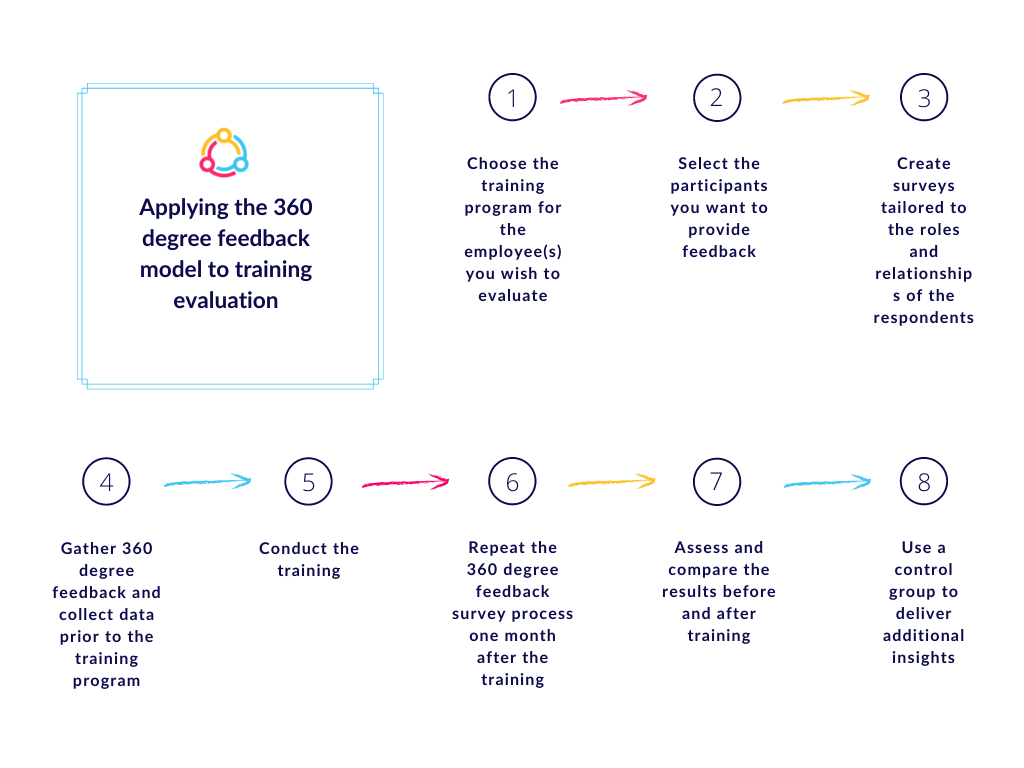
The success or failure of training programs is typically understood through self-reporting of those participating. While this approach does bring some insights, there is often a difference between how an employee feels about training, and the impact this has on a broader scale.
The 360-degree feedback model brings in evaluation from a wide range of perspectives. As well as gathering feedback from self-evaluation, it collects feedback from:
- Subordinates
- Peers
- Supervisors
- Customers
- First-line managers
- Second-line managers
This model can be used to craft surveys that are tailored to a given participant. Performance management tools can be used to craft surveys specific to the participant’s relationship with a given employee. These can then be saved as a template for later use. Metrics can be assigned to the survey questions, which can then be better understood through data analytics.
Method
Applying the 360-degree feedback model to training evaluation is simple. Here are the key steps you need to take:
Choose the training program for the employee(s) you wish to evaluate
Once you’ve identified the skills gaps for a given employee you wish to address, you can select the appropriate training program. Analyse the program to determine the expected outcomes. This will allow you to frame the 360-degree feedback questions to best reflect expectations.
Select the participants you want to provide feedback
Choosing the right participants will get the results you need to measure the success or failure of the training program. Cast as wide a net as possible, including the employees’ colleagues, direct reports and external clients familiar with their work.
Create surveys tailored to the roles and relationships of the respondents
Compile questions that reflect each respondent’s area of familiarity with the employee. These can be customised with performance management tools in a range of templates. They should reflect the areas of competencies and skills the training program is oriented towards improving.
Gather 360-degree feedback and collect data prior to the training program
Deliver the surveys to the participants prior to the training, collecting data on all available metrics. This establishes a baseline of employee performance from which to compare post-training.
Conduct the training
Once you’ve received all the feedback from the respondents, it’s time to carry out the training program. The employee’s team leader or manager should liaise throughout the process, keeping a record of any obstacles experienced. This will ensure they don’t get overlooked when evaluating the training.
Repeat the 360-degree feedback survey process one month after the training
Once the training is complete, some time should be given before repeating the 360-degree feedback. This allows for the respondents to have more experience with the employee’s post-training work habits so they can give a more thorough assessment.
Assess and compare the results before and after training
With two sets of survey data to work with, it’s time to assess and compare the results given. If you’re using performance management tools, you can run data analytics on the results to illustrate the success or failure of training across all metrics. You can also see how the perception of success/failure varies depending on the respondents.
Use a control group to deliver additional insights
The 360-degree feedback model can be enhanced by using a control group if applicable. Running the two phases of feedback for employees who aren’t participating in the training will give you comparison data.





